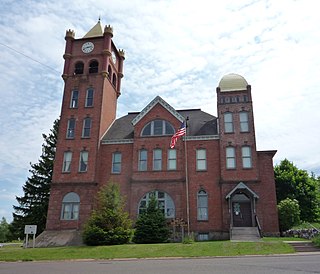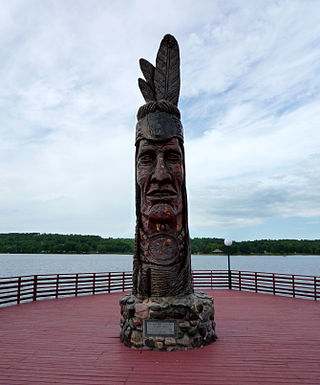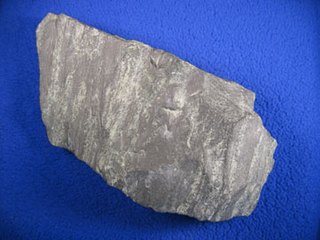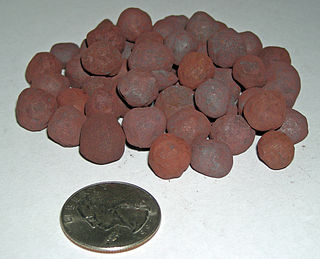Related Research Articles

Iron County is a county located in the U.S. state of Wisconsin. As of the 2020 census, the population was 6,137, making it the third-least populous county in Wisconsin. Its county seat is Hurley. It was named for the valuable iron ore found within its borders. The county overlaps with small parts of the Bad River and Lac du Flambeau Indian reservations.

Ashland County is a county located in the U.S. state of Wisconsin. As of the 2020 census, the population was 16,027. Its county seat is Ashland. The county was formed on March 27, 1860, from La Pointe County. The county partly overlaps with the reservation of the Bad River Band of the Lake Superior Tribe of Chippewa Indians.

Bessemer is a city in the U.S. state of Michigan. As of the 2020 census, the city population was 1,805. It is the county seat of Gogebic County.

Bessemer Township is a civil township of Gogebic County in the U.S. state of Michigan. As of 2020, its population was 1,135.

Ironwood is a city in Gogebic County in the Upper Peninsula of the U.S. state of Michigan, about 18 miles (29 km) south of Lake Superior. The city is on US Highway 2 across the Montreal River from Hurley, Wisconsin. It is the westernmost city in Michigan, situated on the same line of longitude as Clinton, Iowa and St. Louis, Missouri. The population was 5,045 at the 2020 census, down from 5,387 at the 2010 census. The city is bordered by Ironwood Township to the north, but the two are administered autonomously.

Wakefield is a city in Gogebic County in the U.S. state of Michigan. The population was 1,702 at the 2020 census.

Hurley is a city in and the county seat of Iron County, Wisconsin, United States. The population was 1,558 at the 2020 census. It is located directly across the Montreal River from Ironwood, Michigan.

The Mesabi Iron Range is a mining district and mountain range in northeastern Minnesota following an elongate trend containing large deposits of iron ore. It is the largest of four major iron ranges in the region collectively known as the Iron Range of Minnesota. First described in 1866, it is the chief iron ore mining district in the United States. The district is located largely in Itasca and Saint Louis counties. It has been extensively worked since 1892, and has seen a transition from high-grade direct shipping ores through gravity concentrates to the current industry exclusively producing iron ore (taconite) pellets. Production has been dominantly controlled by vertically integrated steelmakers since 1901, and therefore is dictated largely by US ironmaking capacity and demand.

Taconite is a variety of banded iron formation, an iron-bearing sedimentary rock, in which the iron minerals are interlayered with quartz, chert, or carbonate. The name "taconyte" was coined by Horace Vaughn Winchell (1865–1923) – son of Newton Horace Winchell, the Minnesota State Geologist – during their pioneering investigations of the Precambrian Biwabik Iron Formation of northeastern Minnesota. He believed the sedimentary rock sequence hosting the iron-formation was correlative with the Taconic orogeny of New England, and referred to the unfamiliar and as-yet-unnamed iron-bearing rock as the 'taconic rock' or taconyte.

The Iron Range is collectively or individually a number of elongated iron-ore mining districts around Lake Superior in the United States and Canada. Much of the ore-bearing region lies alongside the range of granite hills formed by the Giants Range batholith. These cherty iron ore deposits are Precambrian in the Vermilion Range and middle Precambrian in the Mesabi and Cuyuna ranges, all in Minnesota. The Gogebic Range in Wisconsin and the Marquette Iron Range and Menominee Range in Michigan have similar characteristics and are of similar age. Natural ores and concentrates were produced from 1848 until the mid-1950s, when taconites and jaspers were concentrated and pelletized, and started to become the major source of iron production.

The Vermilion Range exists between Tower, Minnesota and Ely, Minnesota, and contains significant deposits of iron ore. Together with the Mesabi, Gunflint, and Cuyuna ranges, these four constitute the Iron Ranges of northern Minnesota. While the Mesabi Range had iron ore close enough to the surface to enable pit mining, mines had to be dug deep underground to reach the ore of the Vermilion and Cuyuna ranges. The Soudan mine was nearly 1/2 mile underground and required blasting of Precambrian sedimentary bedrock.

The Cuyuna Range is an inactive iron range to the southwest of the Mesabi Range, largely within Crow Wing County, Minnesota. It lies along a 68-mile-long (109 km) line between Brainerd, Minnesota, and Aitkin, Minnesota. The width ranges from 1 to 10 miles.
The following is a list of Registered Historic Places in Iron County, Michigan. The list includes 79 structures and historic districts that are significant for their architectural, historical, or industrial/economic importance.
The Bad River train blockade was a 1996 action on the Bad River Ojibwe Reservation in Ashland County, Wisconsin, carried out by Ojibwe activists against train shipments of sulfuric acid. The activists blocked the railroad tracks that would have brought the acid to a mine in the Upper Peninsula of Michigan. The action brought national scrutiny on the United States Environmental Protection Agency (EPA) and demonstrated the power of Indigenous rights in environmentalism.

The Gogebic Range is an elongated area of iron ore deposits located within a range of hills in northern Michigan and Wisconsin just south of Lake Superior. It extends from Lake Namakagon in Wisconsin eastward to Lake Gogebic in Michigan, or almost 80 miles. Though long, it is only about a half mile wide and forms a crescent concave to the southeast. The Gogebic Range includes the communities of Ironwood in Michigan, plus Mellen and Hurley in Wisconsin.

An ore dock is a large structure used for loading ore onto ships, which then carry the ore to steelworks or to transshipment points. Most known ore docks were constructed near iron mines on the upper Great Lakes and served the lower Great Lakes. Ore docks still in existence are typically about 60 feet (18 m) wide, 80 feet (24 m) high, and vary from 900 feet (270 m) to 2,400 feet (730 m) in length. They are commonly constructed from wood, steel, reinforced concrete, or combinations of these materials.

Copper Falls State Park is a 3,068-acre (1,242 ha) state park in Wisconsin. The park contains a section of the Bad River and its tributary the Tylers Forks, which flow through a gorge and drop over several waterfalls. Old Copper Culture Indians and later European settlers mined copper in the area. The state park was created in 1929 and amenities were developed by the Civilian Conservation Corps and the Works Progress Administration. In 2005 the park was listed on the National Register of Historic Places as a site with 10 contributing properties.
The Taconite State Trail extends 165 miles from Grand Rapids, Minnesota to Ely, Minnesota and intersects the Arrowhead State Trail west of Lake Vermilion. On the Grand Rapids end, the trail is paved for the first 6 miles for in-line skating and biking. The rest of the trail is natural surface used primarily in the winter months for snowmobiling. In the summer, several areas contain standing water, but some areas are suitable for horseback riding, hiking, and mountain biking

Iron mining in the United States produced 48 million metric tons of iron ore in 2019. Iron ore was the third-highest-value metal mined in the United States, after gold and copper. Iron ore was mined from nine active mines and three reclamation operations in Michigan, Minnesota, and Utah. Most of the iron ore was mined in northern Minnesota's Mesabi Range. Net exports were 3.9 million tons. US iron ore made up 2.5 percent of the total mined worldwide in 2015. Employment as of 2014 was 5,750 in iron mines and iron ore treatment plants.
Mary Hayes-Chynoweth (1825-1905) was a psychic leader, mystic, founder of the "True Life Church", and editor of a journal named "True Life". She had two sons, Jaye O. Hayes and Everis A. Hayes.
References
- ↑ "Wis. panel OKs mining bill, sends it to Assembly". Associated Press. 24 Jan 2012. Retrieved 31 January 2012.
- ↑ "Gogebic Taconite, LLC". Hurley, WI website. Hurley, WI Municipal Government. Retrieved 27 January 2012.
- ↑ "GTAC Project Overview". gogebictaconite.com. Gogebic Taconite, LLC. Retrieved 27 January 2012.
- ↑ "Debate on mining bill goes through afternoon". Pierce County (WI) Herald. 26 Jan 2012. Retrieved 27 January 2012.
- ↑ "GTAC Project Overview". gogebictaconite.com. Gogebic Taconite. Retrieved 28 January 2012.
- ↑ Associated Press (9 Jan 2012). "Wisconsin DNR: Mining bill could cost agency millions". Rockford River Star. Retrieved 28 January 2012.
- ↑ "Taconite Mine - Wisconsin Mining Activism". wisconsin.sierraclub.org. Sierra Club, Wisconsin John Muir Chapter. Retrieved 28 January 2012.
- ↑ "Wisconsin's Bonanza. The Newly Developed Mining Region near Hurley. | Turning Points in Wisconsin History | Wisconsin Historical Society".
- ↑ "Iron Mining in Wisconsin (Historic Marker Erected 1992)". Archived from the original on 2014-01-09. Retrieved 2014-01-09.
- ↑ Pitrof, Marge (24 Jan 2012). "Committee Advances Mining Bill". WUWM Milwaukee. Retrieved 28 January 2012.
- ↑ Broman, Claudia (21 Sep 2011). "Bad River Opposes Penokee Mine, Chairman Says". Ashland Current. Retrieved 28 January 2012.
- ↑ Beckett, Andrew (26 January 2012). "Assembly passes mining bill". Wisconsin Radio Network. Retrieved 28 January 2012.
- ↑ "Sierra Club: Mine threatens northern Wisconsin". Associated Press. 11 October 2011. Retrieved 28 January 2012.
- ↑ Bergquist, Lee (27 Jan 2012). "Senate mining bill to differ from version adopted by Assembly". Milwaukee Journal Sentinel. Retrieved 28 January 2012.
- ↑ "MASKED, heavily-armed paramilitary rent-a-cops are freaking out Wisconsin". 9 July 2013.
- ↑ "Gogebic Taconite mining project - Wisconsin DNR". dnr.wi.gov. Retrieved 2016-02-29.